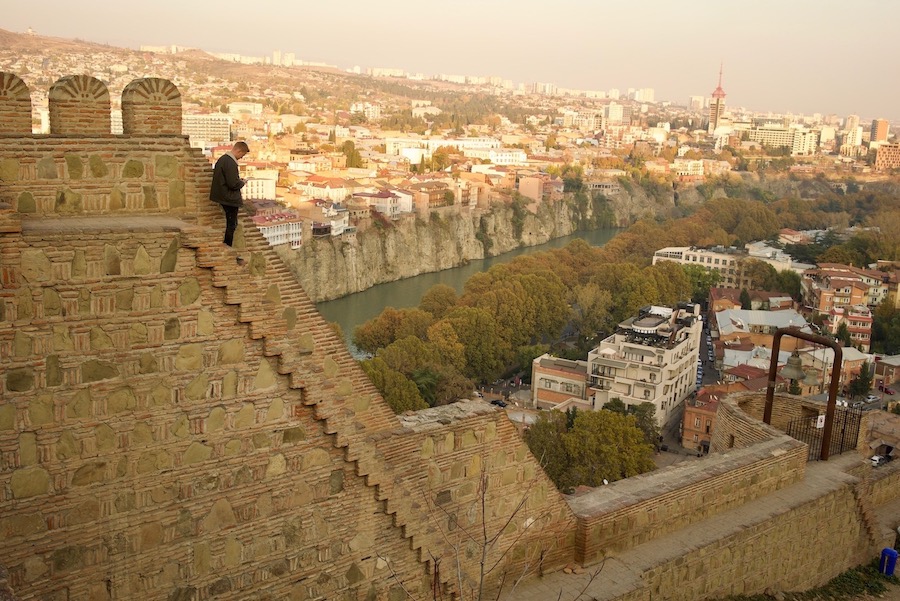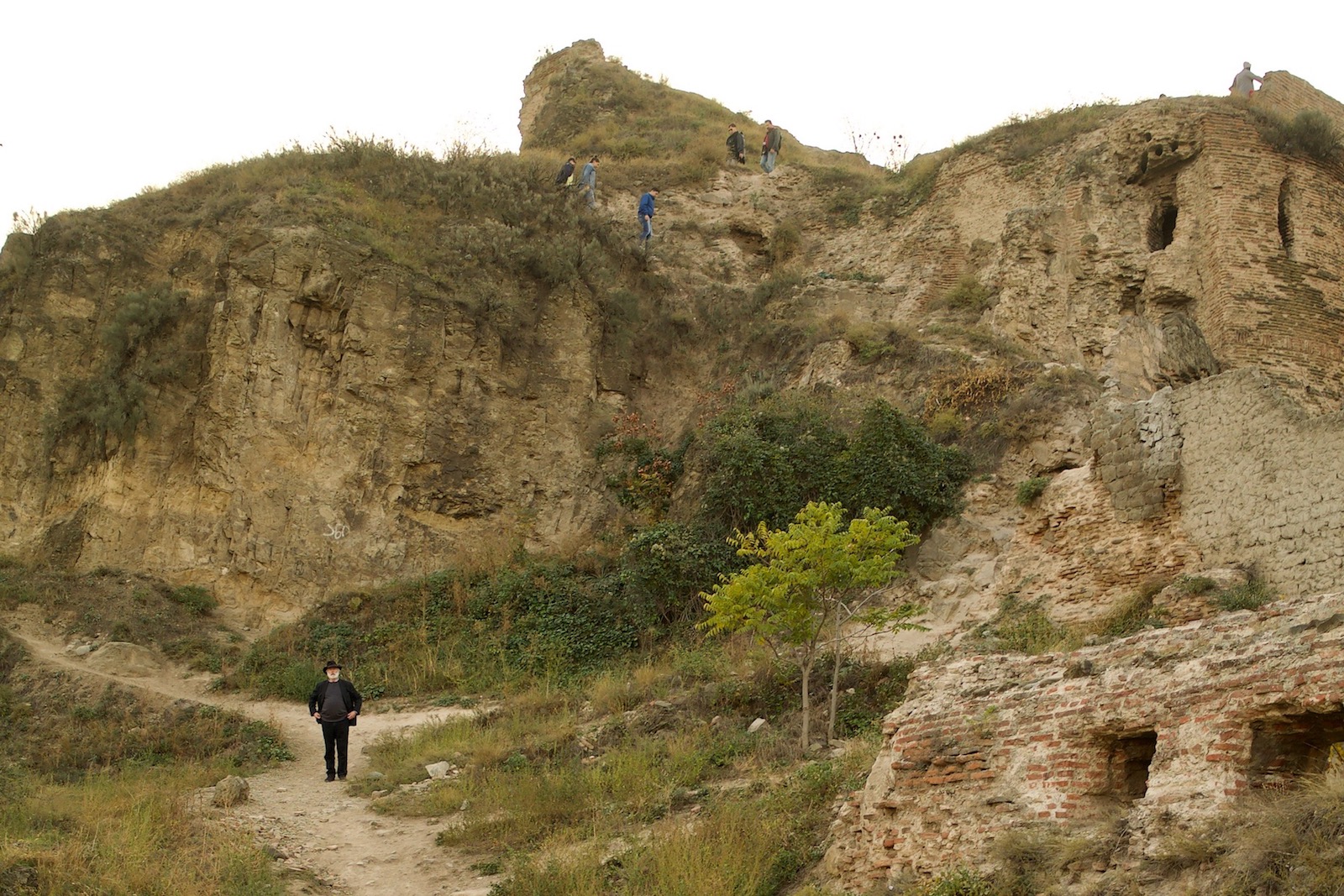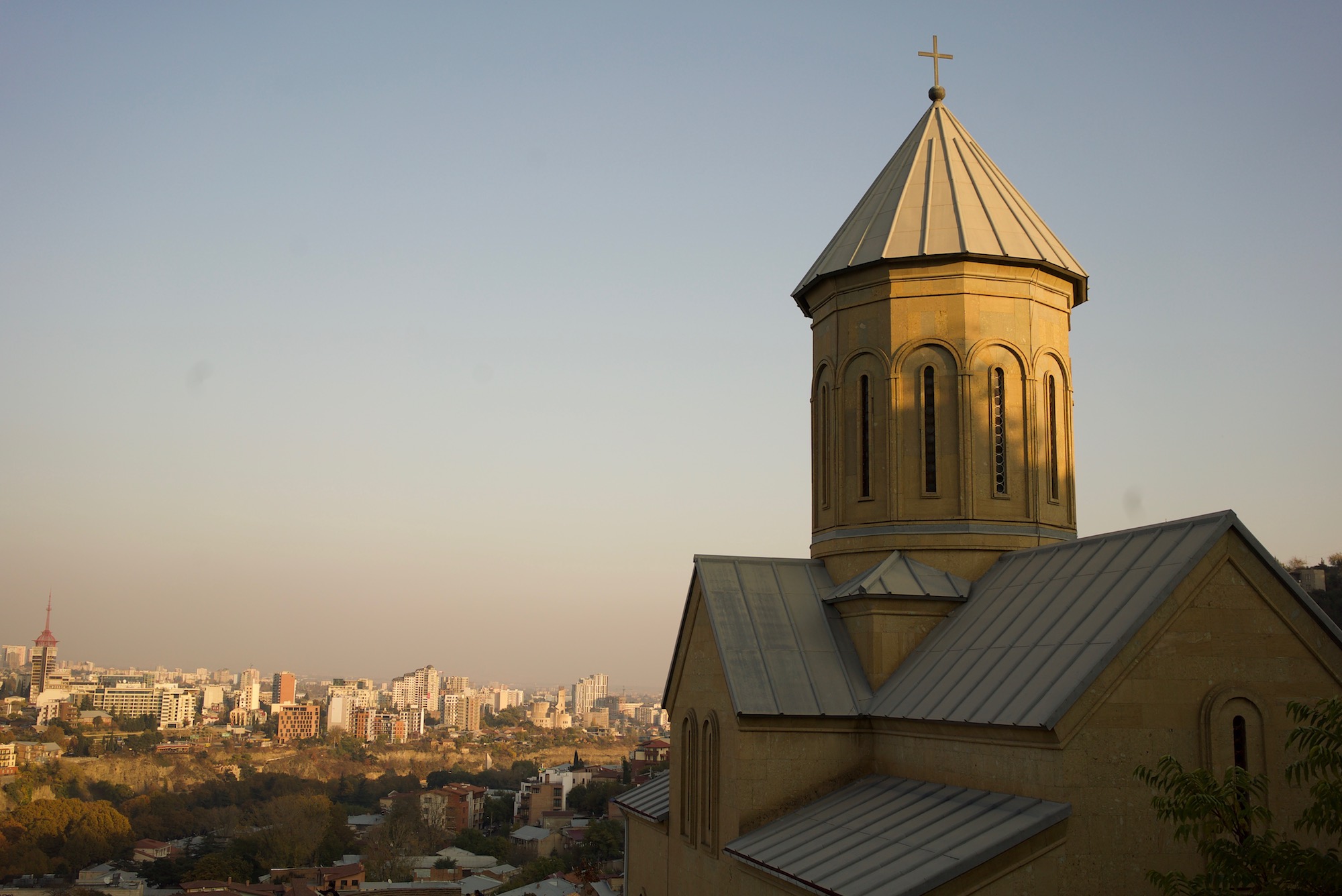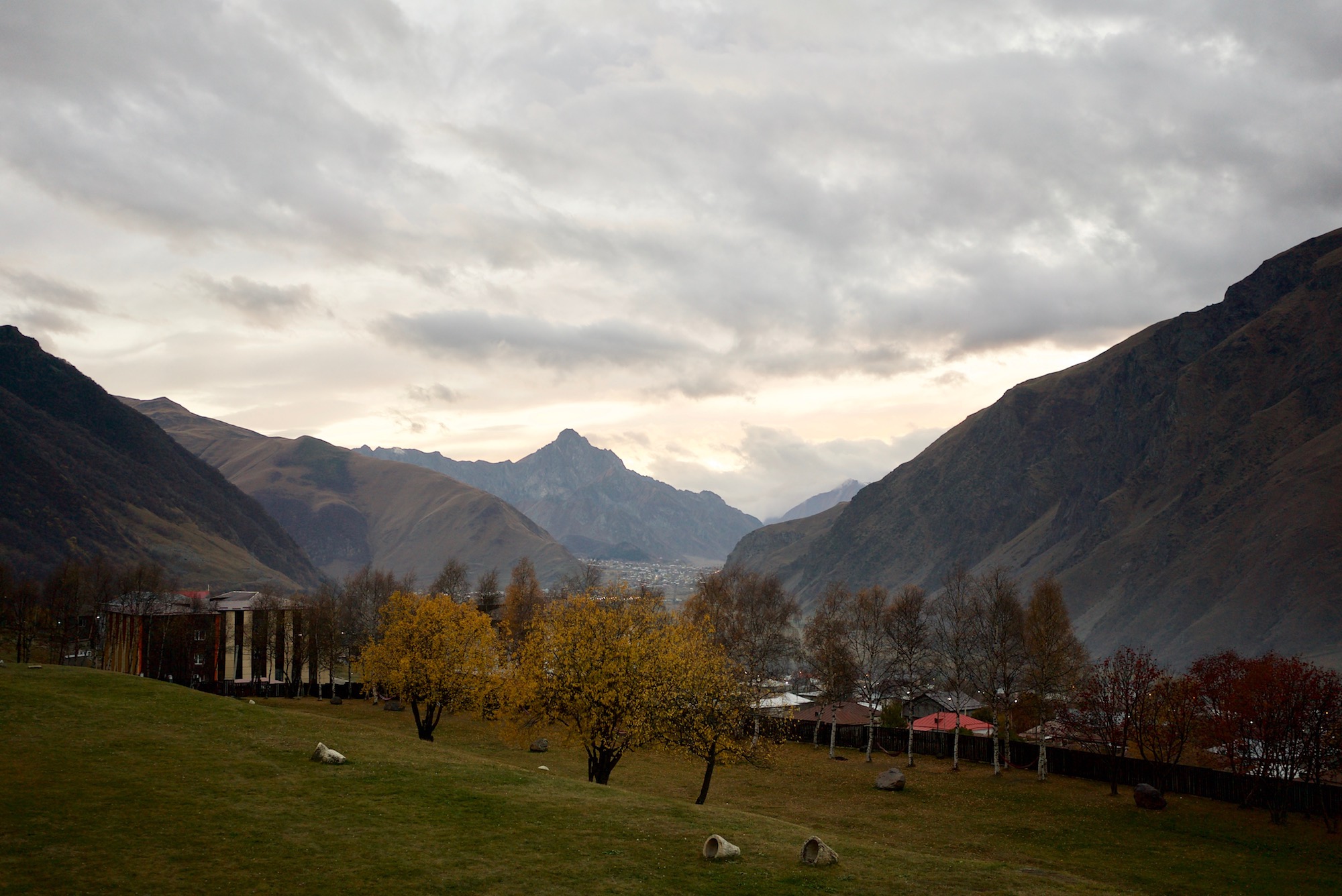ジョージアは旧ソビエト連邦の構成国、黒海やロシア、トルコ、アルメニアやアゼルバイジャンなどに囲まれ、アジアや東ヨーロッパ、中東などの文化が混ざり合い、一言では言い表せない独特の文化を持つ国だ。詳しくはこちらの記事を参照して欲しい。
ジョージアの首都ティビリシでは、大気汚染が深刻な問題となっている。アレルギー体質の自分が街を訪れた時も、中心部の交通量が多いエリアではマスクをつけるほどだった。主な有害物質の原因は、輸送、エネルギー、産業、農業、そして廃棄物。身近に見えるところでは、ディーゼル車や技術的に欠陥のある自動車に乗っている人口が、圧倒的に多いということ。安いという理由でそういった車を購入し、街中で車が故障して止まってしまい、そのまま放置されている車を見ることもしばしばあった。
ティビリシなどの都心部に住む国民は、綺麗な空気を吸いに、街から車で15分程のLisi lake(リシレイク)や、Turtle lake(タートルレイク)まで行ったり、美味しい水を飲みに車で2時間半程の所に位置する、Borjomi (ボルジョミ)という街まで行ったりするそうだ。Borjomiの水は少しソルティーで微発泡、ペットボトルまたは瓶でも販売されていて、スーパーマーケットやコンビニなどで購入できる。
街の中心部には、避けることの難しい最も交通量の多い大通りがあるが、高低差の多い街並みは、空気の澄んだ丘の上まで歩いて行ける距離だ。住宅地から見える丘の上にそびえ立つ彫刻、Kartlis Deda(グルジア母の像)を目指して歩いくと、20分程で丘の上に辿り着いた。
目の前にはティビリシの街が広がり、反対側には 161ヘクタール、東京ドーム約34個分の広大な敷地にある植物園を見下ろせる。

そこからさらに東へ進み、ナリカラ要塞を目指す道のりも、左手には住宅がぎっしり詰まった街並みが、右手には断崖絶壁の下に自然が広がり、まるで別の街を見ているようだ。
20分程歩いていくと、ナリカラ要塞と聖ニコラス教会に辿り着く。ジョージアには教会がたくさんあり、ヨーロッパや中東の教会とはまた違った雰囲気でどれも独特なので、どんなに小さい教会でもふらっと立ち寄ってみるといいかもしれない。
ナリカラ要塞は4世紀に建てられ、19世紀の火薬庫の爆発により一部しか残っていないが、ここから街が一望でき、夜景もさることながら街から見る要塞の夜景も素晴らしい。ロープウェイで登ってくることもできるので、夜はそちらが楽しめるかもしれない。
- All Photos by Natsuko Natsuyama
街の中心部から車で2-30分ほど行ったムツヘタという小さな街には、世界遺産に登録されている教会が3つある。その中でも一番規模は小さいが、6世紀に建てられたジワリ修道院は、他の2つの教会、サムタヴロ教会と修道院スヴェティツホヴェリ大聖堂を見下ろせる丘の上にある。ジワリ修道院は修復の計画性が認められないということで、危機遺産にも登録されているそうだ。
丘からは周辺の街が一望できる。重なり合う山々と川と街のネオンが、サンセットタイムをより一層引き立てる。

ティビリシから車で3時間ほど行ったところに、Kazbegi(カズベキ)というコーサカス山脈に囲まれた田舎町がある。そこにはティビリシに数年前にオープンしたヒップなホテル、Rooms Hotelの姉妹ホテルがあり、レストランやロビー、プールや各部屋から壮大な山々の景色が眺められる。
フォレストビューと称する部屋からは、ロビーやレストランから見える景色同様、広々と広がる山の景色。

マウントビューと称する部屋からは、間近にそびえ立つ山のディテールまでがみえる。

冬にはスキーをしに来る場所としても人気だとか。値段も一泊15,000円から25,000円くらいと、このシチュエーションとクオリティにしてはだいぶ安い設定だ。もちろん併設されているレストランでは、モダンなジョージア料理やワインも楽しめる。一泊と言わず何日間か腰を据えて自然に浸ってみるのも良いかもしれない。
現在のジョージアの首相、Mamuka Bakhtadze(36歳)は、就任時に「グリーン経済」政策を提唱した。今後10年以内に、現在利用されている自動車の90%が電気自動車に買い換えられ、今後1年間で2,000台以上の電気自動車が、カーシェアリングシステムを通じてジョージアに輸入される予定だそう。公共バスの買い換えや、新たな地下鉄の導入も始まるそうだ。さらには、2019年4月からポリエチレン袋の生産・輸入・販売を禁止し、同国の技術基準に準拠した生分解性、堆肥化性のある袋のみ、製造・輸入・販売が可能となるそうだ。独自の文化や言葉を守り続ける一方で、新たな若者のカルチャーも生み出すジョージアの街が、公害への取り組みに加速をかけたら、数年間のうちに唯一無二の国になるかもしれない。
—
All photo by Natsuko Natsuyama
—
Markus Oxelman & Natsuko Natsuyama
2017年、コペンハーゲンでたまたま同じシェアアパートに住んでいたMarkusとNatsukoは、色んな国を行き来するライフスタイル、食やワイン、アートや音楽の趣味が近かったため、すぐに意気投合し多くの時間を共有し始めた。2018年には数ヶ月共にジョージアに滞在した。現在は両者共、コペンハーゲン、東京を行き来しながら、コペンハーゲンやジョージアにまつわる記事を執筆している。
Instagram:
Markus
Natsuko
Georgia
Georgia is a country in Caucasus, former Soviet Union state, bordering the Black Sea, Russia, Turkey, Armenia, Azerbaijan. The culture is Georgian, but has traces of a mix of Asian, Eastern European, and Middle Eastern cultures, that can not be described in a single word. Please see this article for details.
Air pollution is a serious problem in Tbilisi, which is the capital of Georgia. During the visits I made to the city, I used to wear masks in areas with heavy traffic in the centre, as the air gave me allergic reactions. The main sources of harmful substances are transportation, energy, industry, agriculture, and waste. As you can see in statistics, a majority of people are riding diesel and technically defective cars. Those cars are cheap used vehicle commonly bought from foreign markets, sent to Georgia. It’s a common sight to see a broke down car and stopped in the middle of the street, left untouched and abandoned.
The people living in the city centre of Tbilisi who long for clean air usually go to the outskirts of the city to breathe. Lake Lisi and Turtle Lake is about 15 minutes by car from the city. About two and a half hour from Tbilisi, the town Borjomi is located in the green mountainous areas of central Georgia. Borjomi is famous for its water, which is a little salty, slightly sparkling, and sold in bottles at supermarkets and convenience stores all around Georgia.
The bad air is at its worst in the centre of the city, and along the main avenues. But the clear air in the hills surrounding Tbilisi is not far away. When I walked up to the sculpture that rises above the hill in the South-West, Kartlis Deda (Mother of Georgia), I arrived on top of the hill in about 20 minutes from starting by the foot in the old town.
The city of Tbilisi spreads in front of you, and on the other side you can overlook the botanical garden on the huge site of about 41 hectares which corresponds to the size of about 34 times the Tokyo Dome.

From there, we head east and head to the fortress, Narikala. On the left side is a city full of houses, on the right the nature spreads under the rocky hillsides and looks like an complete other city.

Walk for about 20 minutes and you will reach Narikala Fortress and St. Nicholas Church. There are many churches in Georgia, and they are in a different architectural style from those in Europe and the Middle Eastern mosques. It is worth while to stop by as small a church and experience the atmosphere.

The Narikala Fortress was built in the 4th century, and although only a part of it remained due to an explosion of gunpowder in the 19th century. The city can be overlooked from here, and the night view of the fortress seen from the city is also excellent. You can also go there from the old town by ropeway, which also is open in the nighttime.

In a small town called Mtskheta, which is about 20-30 minutes drive from the center of the town, there are three churches recognized as World Heritage Sites. The smallest one, the Giwali Monastery, built in the 6th century, lies on a hill overlooking the other two churches Samtavro Church and the Monastery Sveti Skoveli Cathedral. Ziwali Monastery is also registered as a heritage at risk level because it does have a plan of restoration.

From the hill you can see the surrounding city. Overlapping mountains, rivers and city lights further enhance the light of the sunset time.

A three-hour drive from Tbilisi is a rural town called Kazbegi surrounded by the Northern Caucasus Mountain Range. There is a hip hotel, which is a sister hotel of Rooms Hotel, which opened several years ago in Tbilisi. Rooms Hotel Kazbegi offers magnificent views of Mount Kazbegi from the restaurant, the lobby, the indoor pool and its some of its rooms.

From the room called Forest View you can’t see Mount Kazbegi, but there are rooms with views there as well, and you can still enjoy the views in the common spaces.

From the room called Mount View, you can see the details of the vast mountains.

It is also popular as a place to ski in winter. The price is about 15,000 yen to 25,000 yen per night, which is a fairly cheap considering the quality and views. Of course you enjoy traditional Georgian food with a modern twist and wine at the restaurant. It may be better to stay for a few days and soak in the wonderful nature instead of saying just one night.

The current Georgian prime minister, Mamuka Bakhtadze, aged 36, advocated a “green economy” policy when he took office. Within the next 10 years, 90% of currently used cars will be replaced with electric cars, and over 2,000 electric cars will be implemented in a car sharing system by next year. The replacement of public buses and the construction of a new subway will also begin. Furthermore, it prohibits the production, import and sale of polyethylene bags from April 2019, and it will be possible to only manufacture, import and sell biodegradable and compostable bags conforming to the country’s technical standards. Georgia cities that promoting youth cultures which are raising awareness for pollution while continuing to preserve their own culture and language is important. This may turn Georgia into a role model country in a few years, if it accelerates its efforts to combat pollution.The contrast between the chaotic streets of Tbilisi, and the calm scnerey of nature.
—
All photo by Natsuko Natsuyama
—
Markus Oxelman & Natsuko Natsuyama
Met in 2017 in Copenhagen while they were both staying in the same shared apartment. They bonded quickly over both enjoying the travelling lifestyle, food, wine, art and music among other things. Both are based between Copenhagen and Tokyo but also spends occasional time in Georgia. Started writing about Copenhagen and Georgia in 2018.
Instagram:
Markus
Natsuko
Georgia




















